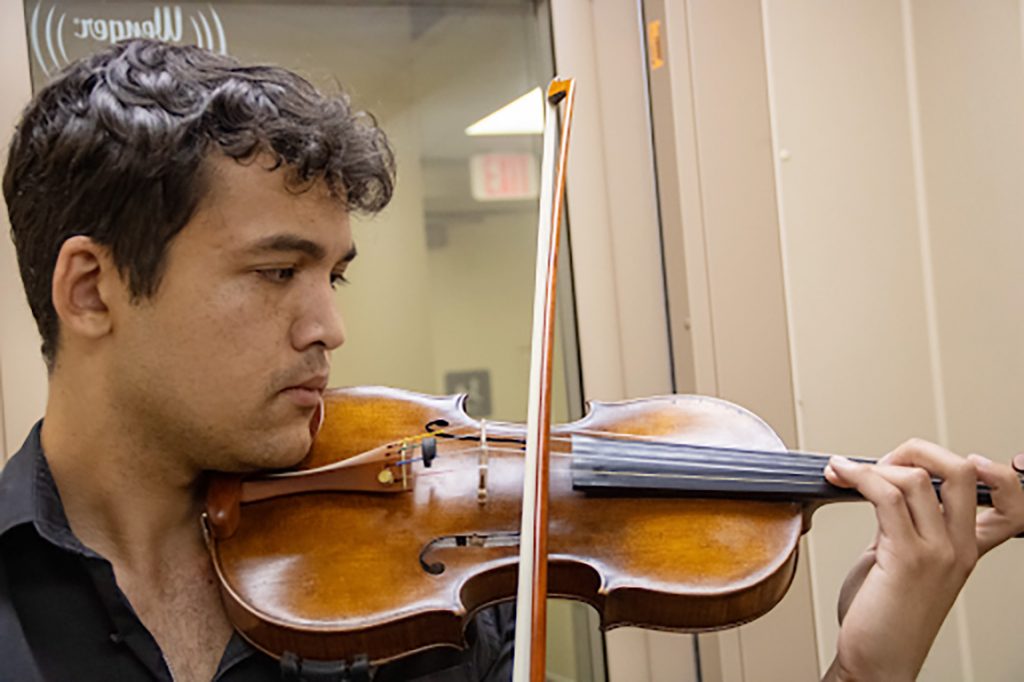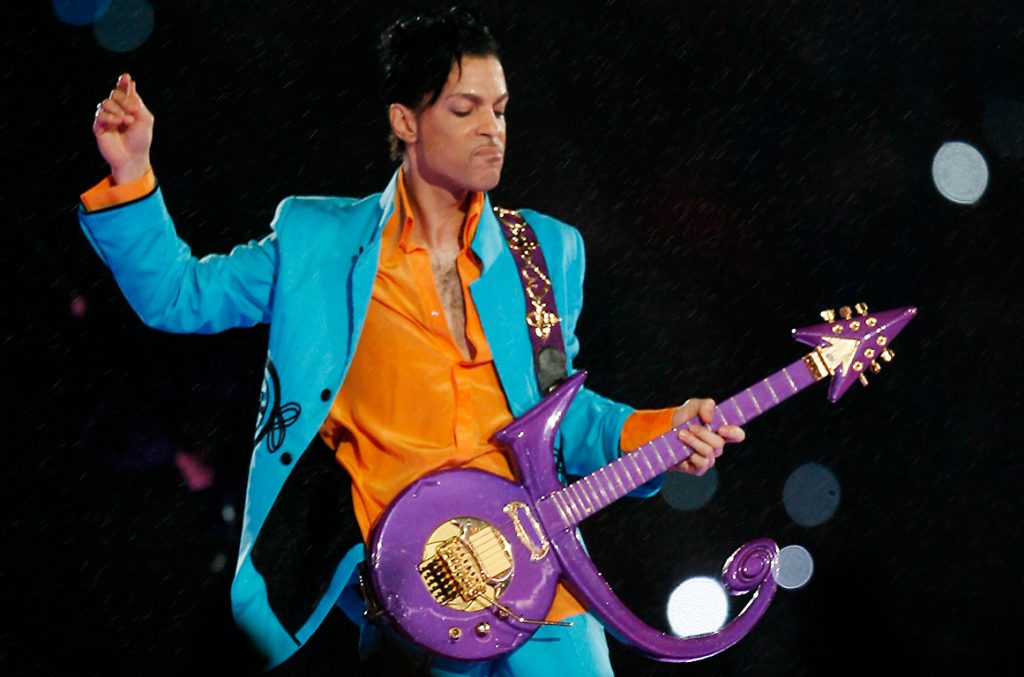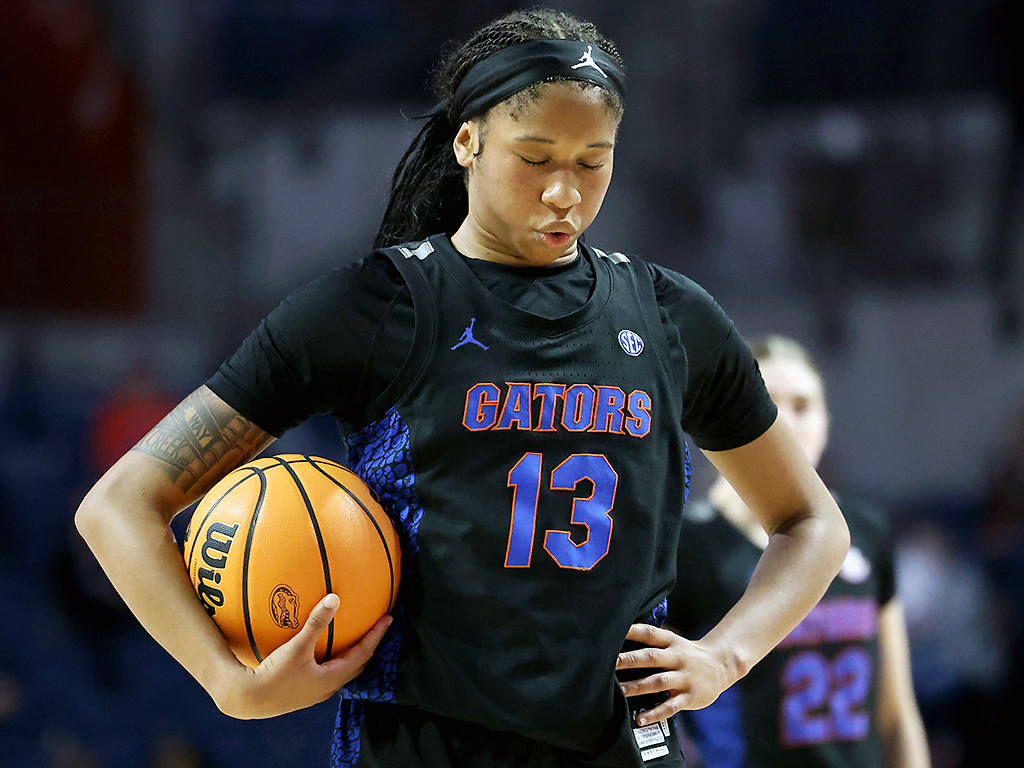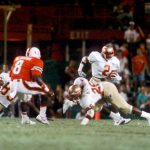Built to Perform: The Hidden Parallels Between Athletes, Musicians
Picture an athlete in your mind, or your favorite sports team.
Now, picture a musician. Think about your favorite band.
You have very different images in your head, right?
Of course you do. On the surface, the typical athlete is a stark contrast from the average musician.
Take a closer look at Laila Reynolds and Juan Florez, for example. Reynolds is a 6-foot-1 junior guard for the Florida Gators women’s basketball team. A former McDonald’s All-American, she averaged 10.3 points, 3.6 rebounds and 2.5 assists in 33 starts last season.
Florez, who stands at 5-11, is a violinist and conductor who is currently in graduate school at the University of Florida, He also performs with the Jacksonville Symphony and the Ocala Symphony Orchestra approximately three times a month.
Reynolds and Florez are both, at their core, performers. Their years of relentless work behind the scenes are critiqued based on a few hours of performance on a given night.
The differences between the two are undoubtedly noticeable, but together, they uncover all the hidden parallels between athletes and musicians.

Putting In Work
The work ethic of the athlete has been publicly idolized forever, and these stories have become immortalized. The greats of their sports — such as Michael Jordan, Tiger Woods or Michael Phelps — have been praised for their unparalleled determination and drive to perfect their craft.
“People don’t understand that when I grew up, I was never the most talented,” Woods once said. “I was never the biggest. I was never the fastest. I certainly was never the strongest. The only thing I had was my work ethic, and that’s been what has gotten me this far.”
Athletes’ work ethic should undoubtedly be highlighted — it is the foundation of their job. But the work ethic of musicians should be highlighted, too.
Some of the most famous musicians — groups like The Beatles, or individuals such as Prince and John Mayer — also have incredible work ethics that match, sometimes even surpass, those of legendary athletes. Prince famously spent all day in the studio, working relentlessly to finish ideas, as well as doing four-hour rehearsals during sound checks of concerts.
Sport and music are both physical and mental art forms that require unbelievable discipline. Both Florez and Reynolds practice their craft for at least two to three hours per day every day, either with group practices and rehearsals or individual reps. During peak season, Reynolds is practicing or playing six days out of the week. When she’s not on the hardwood, she’s busy recovering her body.
On top of that, the precision of how athletes and musicians work is extremely similar. Both must concentrate on connecting their mind and muscles to perform at the highest level.
Former Gators quarterback Danny Wuerffel won the Heisman Trophy in 1996, helping lead Florida to its first national championship that season. Wuerffel studied his throwing motion under a microscope. He even brought baseball coaches to film his throw to pinpoint how to generate more power in his motion.
“I can’t imagine that anybody else on the planet threw more passes than I did trying to get better at that,” Wuerffel said.
Florez, meanwhile, described how he spends countless hours trying to perfect his motions with his fingers. Fine motor skills are needed for a violinist to play such precise melodies and rhythms.
“Sports people are athletes of the big muscles, and musicians are the athletes of the small muscles,” Florez said. “When it comes to the violin, we stretch our neck muscles, our shoulder muscles and our hands. All of these tiny little muscles that need to work perfectly. Twitch reactions are what we need when we play.”

Collaboration & Teamwork
Working together is the foundation of both music and sports. Even solo musicians or athletes competing in individual sports like tennis or swimming still have a supporting cast and team that they work with every single day. For musicians, that may be a producer or studio musicians; for athletes, that may be a trainer or nutritionist.
However, some of the most beloved sports are team sports. Football, soccer and basketball gain such traction because of the team element.
“Teamwork is one of the main things in basketball; you just have to play together,” Reynolds said. “Everybody on the floor has to be connecting to really find success in basketball. We just have to spend time with each other to build that off-court chemistry so we know how each other work on the court and how we can talk to one another.”
It takes work to build a great team. Think about the USA Dream Team, or FC Barcelona with Lionel Messi, Luis Suarez, and Neymar, or even the famous 1927 New York Yankees squad with Babe Ruth and Lou Gehrig. Playing as a collective unit enhances a player’s performance as well as an audience’s attachment to a game. The culmination of personalities, styles, and ability is exciting, and the best teams are often memorialized in the history books.
The same is true for musicians. People fall in love with the group. While solo musicians often succeed, there is a different air around groups like The Rolling Stones, Led Zeppelin, or even the Wu-Tang Clan. Collaboration is a beautiful form of expression. Watching different flavors of people and different styles mesh together to create an outcome is a unique, special moment.
“Music is very much a communal thing,” Florez said. “There is an inherent good in music, it being a thing that brings people together and focuses them on this one very specific goal.”
Wuerffel and the Gators would have won a national champion without the linemen, receivers, running backs and defense. Florez could not showcase the complexities of Mozart or Bach without horns, percussionists, and a conductor. Teamwork is an essential component of both disciplines. Without it, there is no sport, and there is no music.

“[Being a part of a team] is why I love football so much,” Wuerffel said. “What other sports will you have 300-pound men battling [in the trenches] and then a 150-pound kid kicking the ball at the last second to win the game. And they’re all on the same team?”
Performance Preparation
Arguably, the most difficult piece of being an athlete or musician is the brutal truth that all of your work is summed up into a few hours of performance. The multihour practice sessions, the countless reps of trial and error, and the pain endured during the process can unfortunately all be misrepresented in a bad performance.
There is a ton of pressure on the shoulders of athletes and musicians. A bad game can cost a team a season, and a bad recital can cost a musician a career. Athletes and musicians have to train themselves to live with the pressure and use their nerves to their advantage.
“The mentality of it is very much the same — walking onto a pitch right before a game and walking onto a concert hall right before a performance,” said Florez, who played soccer growing up. “You’re conscious of how hard you worked and how much sweat you generated and how much blood you lost on this craft.”
Because their performances are similar, their preparation is similar, too.
Florez, Reynolds and Wuerffel all had a commonality in their pregame prep: clearing their mind.

Florez arrives at his shows early to do breathing and stretching exercises, all to lower his heartbeat and relax. Reynolds stays off social media leading up to a game and takes a shower before stepping onto the court to have some space to herself. After that, she uses music, like worship music or “Run This Town” by Jay-Z, to get out of her head, loosen up, and prepare.
Wuerffel also used music in the locker room, allowing him to “get into a different space.” He would visualize plays in his head and focus on the obstacles he may face during the game.
“One of the keys is to make the routine the same,” Wuerffel said. “Our pregame before the national title was no different than when we were playing a team that wasn’t nearly as good in the middle of the season.”
The most successful athletes and musicians sometimes reach celebrity status, and while on TV or online, they may look like strikingly different people who live strikingly different lives, they actually have more in common than you think.
The work ethic and discipline that the two share, along with the attentiveness to the mental component of their performances, allow athletes and musicians to express themselves uniquely. On top of that, the collaborative component involved in both disciplines is what continues to fascinate audiences and inspire the next generation.
Category: Feature Sports News, Gator Sports, Gators Women's Basketball


